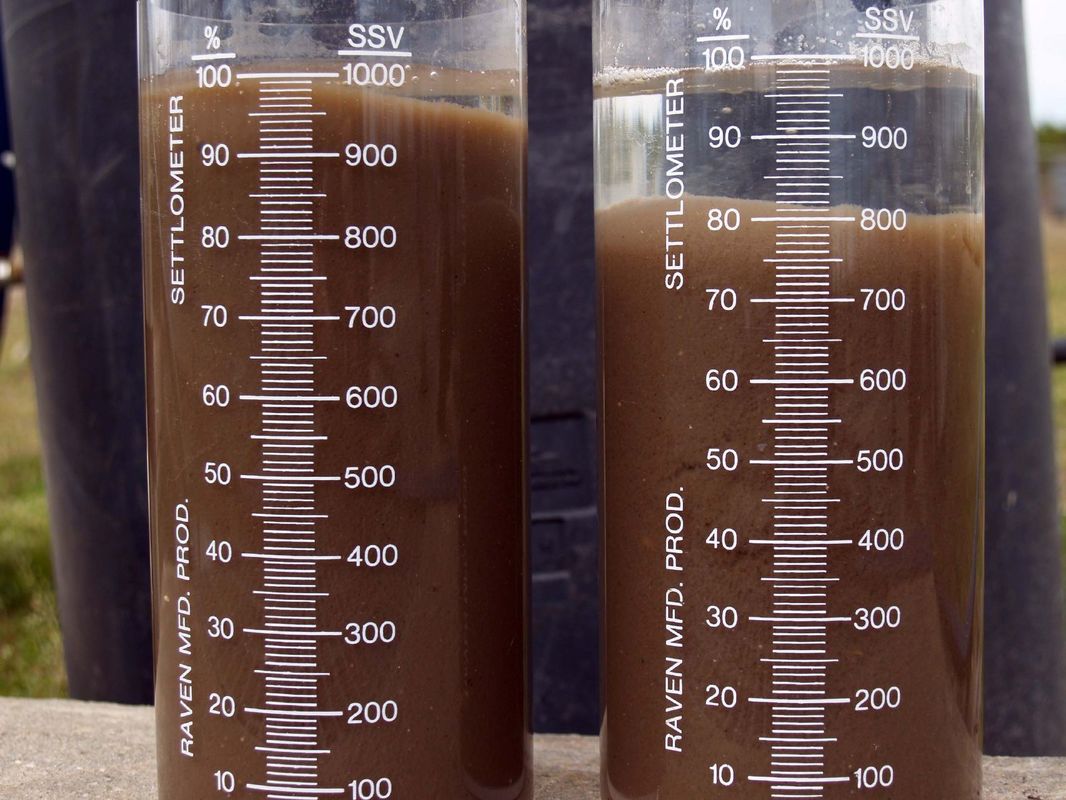- What container should be used for settling tests?
The reason for the larger 2L size is that there is less interference from glass or plastic walls on the settling biomass. While 1L is commonly used, any smaller size has interference. But, the biggest rule is to be consistent and use the same method each time. - Why 30 minutes, when my clarifier has a 2 hour residence time?
The 30 minute settling time is long enough to give information on how the solids will behave in the clarifier. Also, remember this is a batch test without any flows entering or leaving - which happens in the clarifier. The SV30 can be made more useful by recording sludge levels every 5 minutes. Older sludges (low F/M) settle quickly leaving high turbidity, younger sludge (high F/M) does not compact well.
- What are the units in the SV30 test?
SV30 is really a ratio of volume settled sludge per volume mixed liquor. If you use a 1L cylinder it is ml settled sludge per Liter. So we often say SV30 of 400 meaning 40% of the volume occupied by settled sludge after 30 minutes. - How do I calculate SVI from SV30?
When you change mixed liquor suspended solids concentration, it makes sense that the SV30 also changes. To make the SV30 more "standardized", the SVI was created. SVI is calculated by taking the SV30 number and dividing by MLSS in grams (some people use MLVSS instead of MLSS). As in all monitoring, just make sure you use the same test procedure each time. Systems with SVI above 150 are said to be bulking with the ideal range often being given as 100 - 120. Again, this is system specific and develop a range for local equipment and flows.
|
The traditional SV30 test is done in either a 1L graduated cylinder or 2L settleometer (a graduated beaker of sorts).
P ESWARA RAO
10/21/2017 03:55:45 am
If sv30 is very high then what happens in clarifier
Eri
10/21/2017 06:45:55 am
High SV30 - high bed depth & potential solids carryover (TSS). Causes can be filamentous & non filamentous bulking. This is separate from running high MLSS numbers which means more solids, taking up space in the SV30.
Rex fetalver
11/18/2019 05:11:45 pm
My COD is to low 100 mg / L
Erik Rumbaugh
11/19/2019 06:07:52 am
Is that influent COD? Very low loadings can cause problems if you want to maintain a stable biomass. Can you feed a BOD/COD source to keep the biomass - yes. But how long do you need to run before getting "natural" loadings back up should be part of the thought. Sometimes you can let the biomass decrease and naturally return. Comments are closed.
|
AuthorErik Rumbaugh has been involved in biological waste treatment for over 20 years. He has worked with industrial and municipal wastewater facilities to ensure optimal performance of their treatment systems. He is a founder of Aster Bio (www.asterbio.com) specializing in biological waste treatment. Click to set custom HTML
Archives
April 2024
|


 RSS Feed
RSS Feed